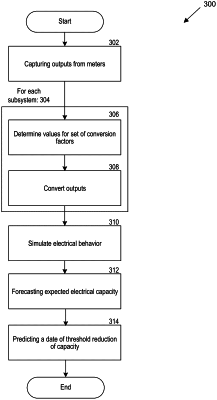| CPC H02J 3/004 (2020.01) [H02J 2203/20 (2020.01)] | 20 Claims |

|
1. A non-transitory, computer-readable storage medium comprising instructions recorded thereon that, when executed by at least one processor of a system of a wireless telecommunications network, cause the system to:
capture outputs of meters coupled to a set of subsystems in a facility,
wherein the outputs are captured over a period of time and a subset of the outputs are expressed in non-standard resource units, and
wherein the set of subsystems includes at least one power system and at least one cooling system;
for each subsystem of the set of subsystems:
determine values for a set of conversion factors related to the subsystem based on a conversion index for the subsystem,
wherein the conversion index is based on inputs from operators of the subsystem, a one-line diagram of the subsystem, and datasheets for components of the subsystem, and
wherein the set of conversion factors describe design and operation of the subsystem; and
convert outputs of the subset of outputs from the non-standard resource units to a standard resource unit based on the values of the set of conversion factors for the subsystem;
simulate behavior of the set of subsystems in the facility based on trends indicated in the converted outputs;
forecast an expected capacity of the facility over a time period based on the simulation of the behavior of the set of subsystems; and
predict, based on the forecast, a date within the time period when a particular subsystem of the set of subsystems will experience a threshold reduction in capacity of the facility.
|